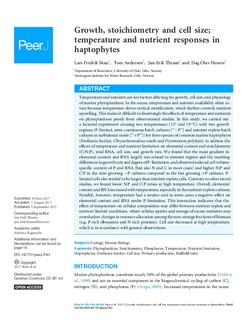Growth, stoichiometry and cell size; temperature and nutrient responses in haptophytes
Journal article, Peer reviewed
Published version
Permanent lenke
http://hdl.handle.net/11250/2504681Utgivelsesdato
2017Metadata
Vis full innførselSamlinger
- Scientific publications [1172]
Sammendrag
Temperature and nutrients are key factors affecting the growth, cell size, and physiology of marine phytoplankton. In the ocean, temperature and nutrient availability often covary because temperature drives vertical stratification, which further controls nutrient upwelling. This makes it difficult to disentangle the effects of temperature and nutrients on phytoplankton purely from observational studies. In this study, we carried out a factorial experiment crossing two temperatures (13 and 19 C) with two growth regimes (P-limited, semi-continuous batch cultures [``�����P''] and nutrient replete batch cultures in turbidostat mode [``CP'']) for three species of common marine haptophytes (Emiliania huxleyi, Chrysochromulina rotalis and Prymnesium polylepis) to address the effects of temperature and nutrient limitation on elemental content and stoichiometry (C:N:P), total RNA, cell size, and growth rate. We found that the main gradient in elemental content and RNA largely was related to nutrient regime and the resulting differences in growth rate and degree of P-limitation, and observed reduced cell volumespecific content of P and RNA (but also N and C in most cases) and higher N:P and C:P in the slow growing �����P cultures compared to the fast growing CP cultures. Plimited cells also tended to be larger than nutrient replete cells. Contrary to other recent studies, we found lower N:P and C:P ratios at high temperature. Overall, elemental content and RNAincreased with temperature, especially in the nutrient replete cultures. Notably, however, temperature had a weaker and in some cases a negative effect on elemental content and RNA under P-limitation. This interaction indicates that the effect of temperature on cellular composition may differ between nutrient replete and nutrient limited conditions, where cellular uptake and storage of excess nutrients may overshadow changes in resource allocation among the non-storage fractions of biomass (e.g. P-rich ribosomes and N-rich proteins). Cell size decreased at high temperature, which is in accordance with general observations.

